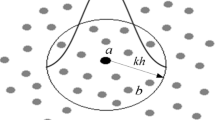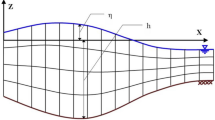Abstract
The paper analyzes the contribution of the sub-particle-scale large-eddy simulation (SPS-LES) turbulent model on the dynamic behavior of the weakly compressible moving-particle semi-implicit (WCMPS) method. To search a robust WCMPS method configuration, the next models are tested: two pressure gradient models, two Laplacian models and the constrained stabilization technique through the control adjustment of the particle velocity by Xu and Jin (Comput Fluids 137:1–14, 2016. https://doi.org/10.1016/j.compfluid.2016.07.014). Then, for these combinations the influence of the SPS-LES turbulent dynamic contributions on the WCMPS method is analyzed. The WCMPS resultant configurations are applied to represent the physics of two different isolated green water events, produced by incoming bores that were generated with the two-dimensional wet dam-break approach. Numerical results captured well the evolution of the green water events, indicating that the WCMPS method can be suitable tool to represent the complex physics of these phenomena, including the breaking features of flow. Moreover, it is shown that even though turbulence is a three-dimensional phenomenon, turbulent contribution can be observable on the velocity field in two dimensions, having a considerable contribution on the adequate representation of green water amounts.






















Similar content being viewed by others
References
Batchelor GK (1967) An introduction to fluid dynamics. Cambridge University Press, Cambridge. https://doi.org/10.1017/CBO9780511800955
Chen X, Xi G, Sun ZG (2014) Improving stability of MPS method by computational scheme based on conceptual particles. Comput Methods Appl Mech Eng 278:254–271. https://doi.org/10.1016/j.cma.2014.05.023
Colagrossi A, Landrini M (2003) Numerical simulation of interfacial flows by smoothed particle hydrodynamics. J Comput Phys 191(2):448–475. https://doi.org/10.1016/S0021-9991(03)00324-3
Colicchio G, Greco M, Faltinsen OM (2011) Domain-decomposition strategy for marine applications with cavity entrapments. J Fluids Struct 27(4):567–585. https://doi.org/10.1016/j.jfluidstructs.2011.03.001
Dalrymple RA, Rogers BD (2006) Numerical modeling of water waves with the SPH method. Coast Eng 53(2–3):141–147. https://doi.org/10.1016/j.coastaleng.2005.10.004
Dao MH, Xu H, Chan ES, Tkalich P (2011) Numerical modelling of extreme waves by smoothed particle hydrodynamics. Nat Hazards Earth Syst Sci 11:419–429. https://doi.org/10.5194/nhess-11-419-2011
Fadafan MA, Hessami-Kermani MR (2017) Moving particle semi-implicit method with improved pressures stability properties. J Hydroinf 20(6):1268–1285. https://doi.org/10.2166/hydro.2017.121
Gotoh H, Shao S, Memita T (2004) SPH-LES model for numerical investigation of wave interaction with partially immersed breakwater. Coast Eng J 46(1):39–63. https://doi.org/10.1142/S0578563404000872
Gotoh H, Khayyer A (2018) On the state-of-the-art of particle methods for coastal and ocean engineering. Coast Eng J 60(1):79–103. https://doi.org/10.1080/21664250.2018.1436243
Gotoh H, Sakai T (2006) Key issues in the particle method for computation of wave breaking. Coast Eng 53(2–3):171–179. https://doi.org/10.1016/j.coastaleng.2005.10.007
Gotoh H, Shibahara T, Sakai T (2001) Sub-particle-scale turbulence model for the MPS method, Lagrangian flow model for hydraulic engineering. Comput Fluid Dyn J 9(4):339–349
Greco M (2001) A two-dimensional study of green-water loading. Norwegian University of Science and Technology
Greco M, Colicchio G, Faltinsen OM (2007) Shipping of water on a two-dimensional structure. Part 2. J Fluid Mech 581:371–399. https://doi.org/10.1017/S002211200700568X
Hernández-Fontes JV, Vitola MA, Silva MC, Esperança PT, Sphaier SH (2018) On the generation of isolated green water events using wet dam-break. J Offshore Mech Arct Eng 140:051101. https://doi.org/10.1115/1.4040050
Hernández I, Hernández-Fontes JV, Vitola MA, Silva MC, Esperança PT (2018) Water elevation measurements using binary image analysis for 2D hydrodynamic experiments. Ocean Eng 157:325–338. https://doi.org/10.1016/j.oceaneng.2018.03.063
Jaime-Ledezma LE, Sanchez-Mondragon J, Vazquez-Hernandez AO, Morales-Viscaya JA, Ochoa-Ruiz G (2019) Simulation of breaking waves on slope beaches integrating the MPS method into Iwagaki wave theory. J Braz Soc Mech Sci Eng 41(4):170. https://doi.org/10.1007/s40430-019-1672-4
Khayyer A, Gotoh H (2009) Modified moving particle semi-implicit methods for the prediction of 2D wave impact pressure. Coast Eng 56(4):419–440. https://doi.org/10.1016/j.coastaleng.2008.10.004
Khayyer A, Gotoh H (2010) On particle-based simulation of a dam-break over a wet bed. J Hydraul Res 48(2):238–249. https://doi.org/10.1080/00221681003726361
Khayyer A, Gotoh H (2011) Enhancement of stability and accuracy of the moving particle semi-implicit method. J Comput Phys 230(8):3093–3118. https://doi.org/10.1016/j.jcp.2011.01.009
Khayyer A, Gotoh H, Shimizu Y (2019) A projection-based particle method with optimized particle shifting for multiphase flows with large density ratios and discontinuous density fields. Comput Fluids 179:356–371. https://doi.org/10.1016/j.compfluid.2018.10.018
Kolahdoozan M, Ahadi MS, Shirazpoor S (2014) Effect of turbulence closer models on the accuracy of MPS method for the viscous free surface flow. Sci Iran 21(4):1217–1230
Kondo M, Koshizuka S (2011) Improvement of stability in moving particle semi-implicit method. Int J Numer Method Fluids 65(6):638–654. https://doi.org/10.1002/fld.2207
Koshizuka S, Nobe A, Oka Y (1998) Numerical analysis of breaking waves using the moving particle semi-implicit method. Int J Numer Method Fluids 26(7):751–769. https://doi.org/10.1002/(SICI)1097-0363(19980415)26:7%3c751:AID-FLD671%3e3.0.CO;2-C
Koshizuka S, Oka Y (1996) Moving-particle semi-implicit method for fragmentation of incompressible fluid. Nucl Sci Eng 123(3):421–434. https://doi.org/10.13182/NSE96-A24205
Lee BH, Park JC, Kim MH, Hwang SC (2011) Step-by-step improvement of MPS method in simulating violent free-surface motions and impact-loads. Comput Methods Appl Mech Eng 200(9–12):1113–1125. https://doi.org/10.1016/j.cma.2010.12.001
Li D, Sun Z, Chen X, Xi G, Liu L (2015) Analysis of wall boundary in moving particle semi-implicit method and a novel model of fluid–wall interaction. Int J Comput Fluid Dyn 29(3–5):199–214. https://doi.org/10.1080/10618562.2015.1028924
Lind SJ, Xu R, Stansby PK, Rogers BD (2012) Incompressible smoothed particle hydrodynamics for free-surface flows: a generalised diffusion-based algorithm for stability and validations for impulsive flows and propagating waves. J Comput Phys 231(4):1499–1523. https://doi.org/10.1016/j.jcp.2011.10.027
Monaghan JJ (1992) Smoothed particle hydrodynamics. Annu Rev Astron Astrophys 30:543–574. https://doi.org/10.1146/annurev.aa.30.090192.002551
Monaghan JJ (1994) Simulating free surface flows with SPH. J Comput Phys 110(2):399–406. https://doi.org/10.1006/jcph.1994.1034
Morris JP, Fox PJ, Zhu Y (1994) Modeling low Reynolds number incompressible flows using SPH. J Comput Phys 136(1):214–226. https://doi.org/10.1006/jcph.1997.5776
Ng KC, Hwang YH, Sheu TWH (2014) On the accuracy assessment of Laplacian models in MPS. Comput Phys Commun 185(10):2412–2426. https://doi.org/10.1016/j.cpc.2014.05.012
Ryu Y, Chang KA (2008) Green water void fraction due to breaking wave impinging and overtopping. Exp Fluids 45(5):883–898. https://doi.org/10.1007/s00348-008-0507-3
Sahebari AJ, Jin YC, Shakibaeinia A (2011) Flow over sills by the MPS mesh-free particle method. J Hydraul Res 49(5):649–656. https://doi.org/10.1080/00221686.2011.607302
Sanchez-Mondragon J (2016) On the stabilization of unphysical pressure oscillations in MPS method simulations. Int J Numer Methods Fluids 82(8):471–492. https://doi.org/10.1002/fld.4227
Sanchez-Mondragon J, Vazquez-Hernandez O (2018) Solitary waves collisions by double-dam-broken simulations with the MPS method. Eng Comput 35(1):53–70. https://doi.org/10.1108/EC-04-2016-0142
Shakibaeinia A, Jin YC (2010) A weakly compressible MPS method for modeling of open-boundary free-surface flow. Int J Numer Methods Fluids 63(10):1208–1232. https://doi.org/10.1002/fld.2132
Shao S (2006) Simulation of breaking wave by SPH method coupled with k-ϵ model. J Hydraul Res 44(3):338–349. https://doi.org/10.1080/00221686.2006.9521686
Shao S, Lo EYM (2003) Incompressible SPH method for simulating Newtonian and Non-Newtonian flows with a free surface. Adv Water Resour 26(7):787–800. https://doi.org/10.1016/S0309-1708(03)00030-7
Shao S, Ji C (2006) SPH computation of plunging waves using 2-D sub-particle scale (SPS) turbulence model. Int J Numer Methods Fluids 51(8):913–936. https://doi.org/10.1002/fld.1165
Shao S, Gotoh H (2005) Turbulence particle models for tracking free surfaces. J Hydraul Res 43(3):276–289. https://doi.org/10.1080/00221680509500122
Shibata K, Masaie I, Kondo M, Murotani K, Koshizuka S (2015) Improved pressure calculation for the moving particle semi-implicit method. Comput Part Mech 2(1):91–108. https://doi.org/10.1007/s40571-015-0039-6
Schwaiger HF (2008) An implicit corrected SPH formulation for thermal diffusion with linear free surface boundary conditions. Int J Numer Methods Eng 75(6):647–671. https://doi.org/10.1002/nme.2266
Skillen A, Lind S, Stansby PK, Rogers BD (2013) Incompressible smoothed particle hydrodynamics (SPH) with reduced temporal noise and generalised Fickian smoothing applied to body-water slam and efficient wave-body interaction. Comput Methods Appl Mech Eng 265:163–173. https://doi.org/10.1016/j.cma.2013.05.017
Smagorinsky J (1963) General circulation experiments with the primitive equations: I The basic experiment. Mon Weather Rev 91(3):99–164. https://doi.org/10.1175/1520-0493(1963)091%3c0099:GCEWTP%3e2.3.CO;2
Stoker JJ (1957) Water waves: pure and applied mathematics. Text Interscience Publishers, New York
Tanaka M, Masunaga T (2010) Stabilization and smoothing of pressure in MPS method by quasi-compressibility. J Comput Phys 229(11):4279–4290. https://doi.org/10.1016/j.jcp.2010.02.011
Tsuruta N, Khayyer A, Gotoh H (2013) A short note on dynamic stabilization of moving particle semi-implicit method. Comput Fluids 82:158–164. https://doi.org/10.1016/j.compfluid.2013.05.001
Xu T, Jin YC (2016) Improvements for accuracy and stability in a weakly-compressible particle method. Comput Fluids 137:1–14. https://doi.org/10.1016/j.compfluid.2016.07.014
Acknowledgements
The author Sanchez-Mondragon J. would like to thank Dirección de Cátedras CONACyT for the support given during the creation of this manuscript. The author Hernández-Fontes J.V. thanks the support provided by DGAPA-UNAM postdoctoral fellowship.
Author information
Authors and Affiliations
Corresponding author
Ethics declarations
Conflict of interest
The authors declare that they have no conflict of interest.
Additional information
Publisher's Note
Springer Nature remains neutral with regard to jurisdictional claims in published maps and institutional affiliations.
Electronic supplementary material
Below is the link to the electronic supplementary material.
Appendix: Reduced parameter on constrained stabilization technique
Appendix: Reduced parameter on constrained stabilization technique
To adjust the constrained stabilization technique, as shown in Eq. (18), by the reduced parameter values on the CWCMPS method by Xu and Jin [48], we tested the following constant values: \( rpv = 0.0005 \), \( 0.0010 \), \( 0.0020 \) and \( 0.0050 \), on the parameter \( \Delta r_{i} = rpv l_{i} \). This test is developed on the same conditions of the wet dam-break of the case A (Table 2 and Fig. 2). This test is independent on the two pressure gradient models probed, because the global behavior is similar to every case. Then, from the pressure gradient models by Lee et al. [25] [Eq. (9)] and Sanchez-Mondragon [34] [Eq. (10)], in this appendix the results from the Lee et al. [25] pressure gradient model [Eq. (9)] are shown, because they had the best performance to stabilize the velocity vector behavior. Moreover, because results are also independent from Laplacian model, we decided to present the results from the Koshizuka et al. [23] Laplacian model, as shown in Eq. (12).
Thus, pressure distributions are compared with experimental snapshots and the WCMPS case configured without constrained stabilization technique [Eq. (18)], as shown in figures for \( t1 \), \( t2 \) and \( t3 \) snapshots from Table 3. Results are shown in Fig. 23. From this figure, at \( t1 \) snapshots, it is shown that the free-surface particles are more stable when the \( rpv \) parameter increases, and then, at \( rpv = 0.0020 \) and \( rpv = 0.0050 \), there are less unstable particles. Also, at \( t2 \) snapshots, when green water collides against the wall step, the height of water jet tends to decrease as the \( rpv \) parameter increases. This shows the oversuppressed forces by high \( rpv \) values, as \( rpv = 0.0050 \). Moreover, from \( t3 \) time figures, the water jet from green water event decreases when the \( rpv \) parameter increases; then, for the \( rpv = 0.0020 \) value, water column is highly suppressed. Furthermore, for time figures at \( t3 \) snapshots, results from parameter values \( rpv = 0.0005 \) and \( rpv = 0.0010 \) present similar behavior compared to experimental snapshots and the WCMPS case configured without the constrained stabilization technique [Eq. (18)]. From this analysis, and by considering the major contribution of the \( rpv \) parameter without affecting physical behavior, we decided to use the value of \( rpv = 0.0010 \) for all numerical calculations.
Comparison of experimental results with the numerical pressure field distribution at the green water development for case A, as shown in Table 2. Numerical calculations configured with the Lee et al. [25] pressure gradient model [Eq. (9)], by the standard WCMPS case and the CWCMPS case by Xu and Jin [48] using the reduced parameter values \( rpv = 0.0005 \), \( rpv = 0.0010 \), \( rpv = 0.0020 \) and \( rpv = 0.0050 \) on the CWCMPS1 to the CWCMPS4 cases, respectively
Rights and permissions
About this article
Cite this article
Sanchez-Mondragon, J., Hernández-Fontes, J.V., Vázquez-Hernández, A.O. et al. Wet dam-break simulation using the SPS-LES turbulent contribution on the WCMPS method to evaluate green water events. Comp. Part. Mech. 7, 705–724 (2020). https://doi.org/10.1007/s40571-019-00302-8
Received:
Accepted:
Published:
Issue Date:
DOI: https://doi.org/10.1007/s40571-019-00302-8





